Words from the President
– Ravi Kandikonda
This year, Asha for Education marked 19 years of service: Today, volunteers from chapters in seven countries raise funds and support deserving projects across India. I have tried to capture a summary of the fundraising events, project initiatives and other organizational efforts that enable us to do all this.
As a global organization, Asha for Education raises funds in several countries. We started the year with an opening balance of $6.68 million and ended it with a balance of $6.59 million, a net reduction in the total assets. Every year we aim to keep a reserve balance to support committed projects and redirect our donor contributions to projects as quickly as we can. In short, we try to keep our cumulative disbursal ratio as close to 100% as possible.
This year, Asha raised more than $3.44 million and incurred expenses of over $3.53 million of which more than $3.1 million were given to 196 well deserving projects.
Organization:
Asha’s democratic decision-making body, ARC (Asha Representative Council) allows Asha to take organization-wide decisions with inputs, feedback and, most importantly, votes from all chapters. This allows each Asha chapter to have a say in determining the direction that Asha takes in tactical and strategic issues faced by the organization. The process was revamped using the same democratic process and installed a better one that is now helping Asha take time-bound decisions. Many chapters participated in the overhaul and I thank everybody on behalf of the coordination team.
Project Partners:
Asha granted over $3.1 million to 196 projects. The project partners ranged from large-scale initiatives like the AVEHI Charitable Trust in Mumbai, Maharasthra and Champa Mahila Society in South 24 Parganas, West Bengal (who received commensurately large contributions) to large number of medium-scale and grassroots-level initiatives that interested particular Asha chapters. Volunteers at various chapters of Asha for Education view the organization mainly as an empowering entity that identifies critical work being done in the most affected and needy areas and enables them to do what they set out to do.
Events, Fundraisers, and Awareness:
Many chapters of Asha planned multiple fundraisers through the year and raised a lot of awareness of the issues that our project partners address on the ground. Our flagship event, titled the ‘Work An Hour’ campaign, ran in the latter half of the year exhorting donors around the world to symbolically donate an hour’s worth of their time to education-related projects. This year the campaign supported 28 schools across 13 projects raising more than $92,000 USD in a short span of time. This campaign brought the widest possible exposure to some of our long-term projects doing exemplary work in India. We expect to hold similar campaigns every year for the foreseeable future.
Challenges:
I would like to take this opportunity to highlight a key challenge faced by many chapters while trying to disburse funds to Asha’s project partners. Before approving funds for a project, Asha requires that someone Asha trusts visit the project and submit a report. In the early years, there were fewer projects and most of them were in urban areas. Hence, volunteers visiting India were able to take time off and visit the projects themselves. But since the number of projects that Asha is supporting has grown substantially and more rural areas have been reached, it is becoming harder to visit the projects in a timely manner and approve funds. This continues to challenge the organization and many solutions are being considered including creating a new track in the Asha Fellowship program and have dedicated ‘site visit experts’ supported by common funds. I’m sure the organization will find a solution as the volunteers are some of the brightest minds I have worked with anywhere.
Conclusion:
We continue this journey that started 19 years ago to make a small but sure dent in the vicious cycle that has denied basic and fundamental rights to a large section of the Indian society. We hope that others will join us in this journey as volunteers, donors, project partners, grant-givers, patrons and even site visit volunteers. We fully understand that we are looking at a mountain of a problem but like many other organizations, Asha is chipping away slowly but steadily to create equal opportunities for people who have been at a disadvantage right from their birth. We take tremendous joy in the organization’s achievements, no matter how small, as we are sure they are moving us in the right direction.
Door Step School
– Vidyanand Rajpathak, Asha Seattle
Door Step School (DSS) is an NGO working to provide literacy to marginalized sections of society. It was established in Mumbai in 1988 and expanded to Pune in 1989. Though the infrastructure of formal education is extensive, many children are not touched by it; for example, children of pavement dwellers, slum dwellers, construction-site families and other underprivileged families. They are not enrolled in regular schools and have limited access to books and places to study. Additionally, many children drop out to work or care for younger children. DSS is trying to bring education to the “doorstep” of these underprivileged children. It has two programs:
- Foundation (direct education program): This helps children in slums, pavement communities and construction sites by setting up classes where children are. Its “School on Wheels” buses serve as mobile classrooms for children. It offers non-formal education (NFE) to 6 to 14-year-olds who cannot go to school, study classes for school-going children in the 1st and 2nd grades, balwadis for 3 to 5-year-old preschoolers and crèches for newborns to 3-year-olds. The program also transports children to municipal schools and collects them from different construction sites to one location. Further, DSS helps children with age certificates, school enrolment and external examinations.
- Grow With Books (school intervention program): This is a 90-minute per (school) week program for students of municipal schools. Its goal is to enhance reading abilities of the children and inculcate reading habits in them. Currently, DSS has this program in 131 schools in Pune and the Pimpri-Chichwad area.
Success Stories
Sehnaj of Pashankar center has been attending NFE classes since 2007. In April 2007 she appeared for the 1st grade external examination and stood first. In spite of her success, her parents were not keen to enroll her in a Pune Municipal Corporation (PMC) school. The urging of the DSS coordinator failed to convince them to do otherwise. She moved to her native place but was so eager to study that she carried books with her. When she returned, she had completed most of the syllabus for the 4th grade. The external examination for the 4th grade was held on 18 April 2009. Due to some difficulty, Sehnaj could not reach Pune before the examination but reached the day after. The DSS coordinator requested the authorities of Sarva Shiksha Abhiyan to allow her to appear for the exam. She was allowed and passed with 62%. Sehnaj’s determination and success in the examination made her mother agree to let her enroll in a Pune Municipal School but her father was still reluctant. With relentless efforts over two years, the DSS coordinator finally convinced her father to enroll her. In June 2009, she was enrolled in the 5th grade of Sant Tukaram School, Pashan.
Komal lives in a community slum adjacent to the DDS center at Pashankar Vitbhatti. After persistent efforts by DSS teachers and coordinators her parents were convinced to enroll her in the NFE classes when she was nine. She was enrolled in a municipal school at Pashan next year. She excelled in school. Though she was older than her classmates, she continues her education without any hesitation and is determined to complete her education. Now her parents are also convinced and they support her education wholeheartedly. She is 13 years old and studying in the 4th grade. She stood first in the annual examination for the 3rd grade. This year she was selected for a scholarship exam by her school.
Indian Ocean 2010
The Making of a Fundraiser
– Venkatesh Iyengar, Asha Silicon Valley
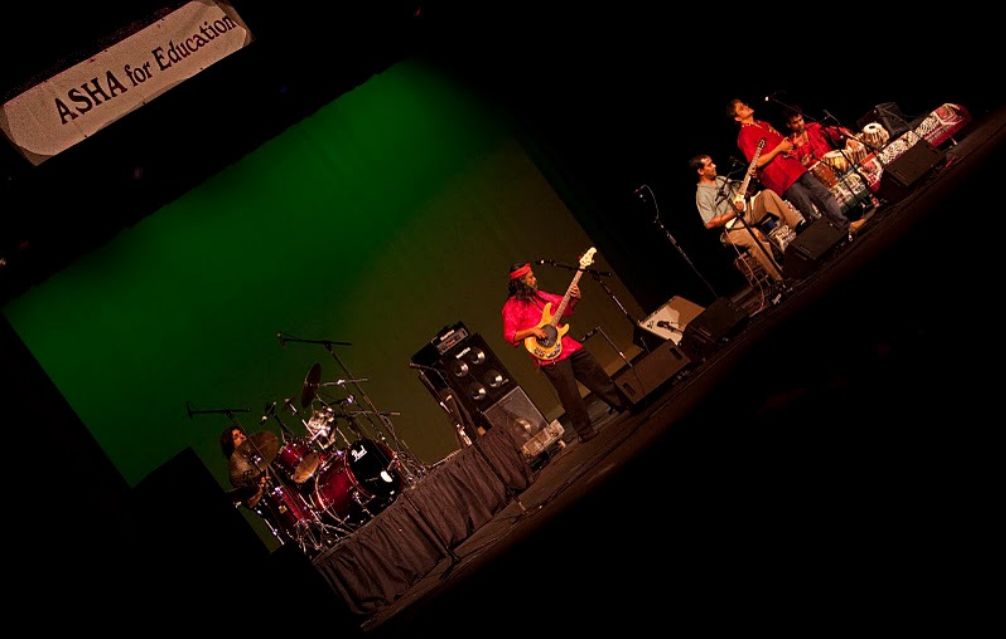
Every year, Asha SV tries to organize a single-day fundraiser in the fall, typically a concert by a local group. Apart from raising funds for our projects, these fundraisers help greatly in spreading awareness about Asha, bringing together many volunteers, finding new volunteers and creating energy and a sense of togetherness in a chapter. This year’s performance was by the popular Indian rock band Indian Ocean. Indian Ocean is a contemporary fusion music band from Delhi whose music has been described by some critics as “Indo-rock fusion with jazz spiced rhythms that integrates shlokas, sufism, environmentalism, mythology and revolution.” The band has three longstanding members – Susmit Sen, Amit Kilam and Rahul Ram, and two new members, Himanshu Joshi and Tuhin Chakraborty. Their famous albums include Indian Ocean, Desert Rain, Kandisa, Jhini, Black Friday, Peepli Live and 16/330 Khajoor Road.
The beginning: The band’s only available date in USA, 20 August, was just eight weeks away. So we had far less lead time than we were used to. Moreover, since this would be a big production, costs were going to be much higher than usual. So we had to have very good publicity and sales plans. We booked a hall at Spangenberg theatre (seating capacity of about a thousand) and drew up budgets and worked out ticket prices and levels based on this venue.
The plan: We focused heavily on large sponsorships given that the band was well-known and was expected to draw a large crowd. We ended up with many sponsors. We also explored many publicity avenues – emails to corporate mailing lists and other NPOs, a few timely lucky draws and, of course, word of mouth. For want of volunteers and time, we did not use flyers and stuck to posters instead, covering as many Bay Area businesses as possible.
The last week: The rest of the preparations went into full gear in the last week. The brochure was finalized with our sponsors’ ads, projects we wanted to showcase, write-ups about Asha and the band and went for print. We also got flyers advertising the many things Asha does, for the Asha booth. Plans were drawn for booth layout, for handling the food distribution/sale and how to incorporate a “green” approach into this process. We talked to other NPOs offering them booth space at the event.
The MCs worked with the band to figure out the program schedule and we worked on our video for the halftime presentation. Audio equipment was rented and the sound/stage setup was arranged. Banners were collected and Asha merchandise prepared.
The band arrived from India and was picked up and hosted by Asha volunteers. We had sold only 500 tickets a week before the event, but thanks to a great sponsorship run we had already broken even at about 250 tickets. However, we really hoped for a full house and sure enough by the day of the concert, with a final push we sold about 800 tickets.
The concert: True to form, volunteers from Asha SV showed up in droves on the day of the event in the true spirit of Asha to make the event a wonderful success. Everything went more or less to script and the concert was well received. In the end, the event turned out to be the highest grossing single-day fundraiser in SV history. We had close to 900 in attendance, made $17K in sponsorships and a net of $31K, and learnt many good lessons for the future.
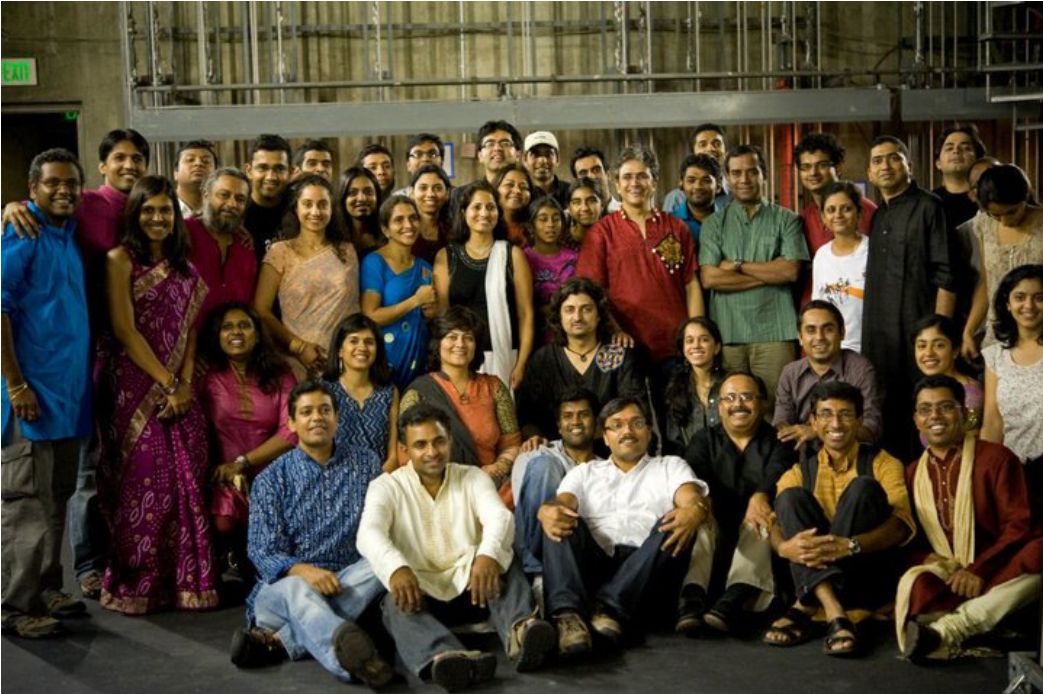
A day in Puvidham:
– Meenakshi Venkatachalam, Asha Silicon Valley
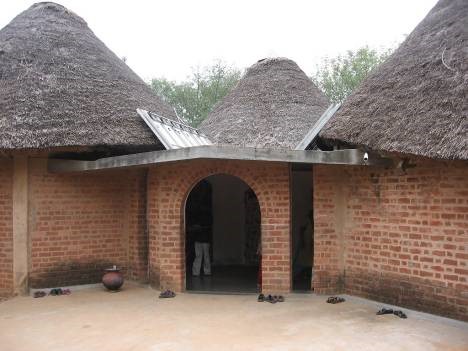
Asha works closely with project partners in a wide range of education-related and development-related efforts. To ensure the effectiveness of these projects, we monitor and evaluate them in various ways. One of the key elements of monitoring is regular site visits. These are done by volunteers or friends of Asha and are documented on the project page for public viewing. Site visits help Asha not only maintain a transparent relationship with our donors but also understand the issues faced by the projects. The article below is on a site visit done to project Puvidham, supported by various chapters of Asha since 2004.
About 15 children stopped their activities, moved their personal mats to the corner and started hopping, jumping, crawling, skipping, etc. from one end of the room to another as part of their exercises before lunch. These are kindergarten children in Puvidham. Each child is given a small cloth mat to use while at Puvidham and do anything it likes on it – keep counting objects, words, pictures, and the like. The idea is to develop a notion of privacy and private space early in childhood.
Puvidham is a school in a small village in Tamil Nadu, 30 km from Dharmapuri. It teaches children till 7th grade. About 100 children attend. It also provides a hostel for children whose parents have migrated to nearby cities like Bangalore in search of work. The hostel is a kilometer from the school. 56 students, boys and girls, stay there.
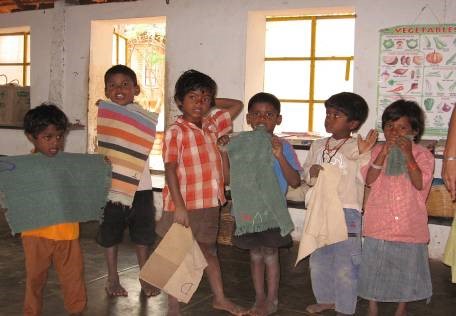
Puvidham was started by Meenakshi Umesh in 2000 on a 12-acre piece of rocky land. Meenakshi and her husband spent much time and energy in making the land cultivable. They planted trees, trained themselves in pest management and started practicing self-sustaining organic farming of rice, ragi and jowar. The school is based on the ideologies of Rabindranath Tagore and Mahatma Gandhi, using methods demonstrated by Maria Montessori and David Horsburgh.
The children are placed in classes based on age. Activities vary from one age group to another. The younger children enjoy clay jigsaw puzzles, pronunciation games and nursery rhymes. The older ones are taught science, social science and mathematics and engage in farming related activities such as drawing village maps, making weather vanes and sun dials, designing better tools for plantation, and experimental farming on small plots of land.
Importance is given to creative extracurricular activities like clay modeling, drawing, conducting puppet shows and stitching. Story telling is considered important because it gives each child the confidence to speak. Children are encouraged to help at home and are taught about their responsibilities to their families, so that the parents do not lose out on helping hands at home. The hostel is located on a four-acre piece of land cultivated for a variety of crops.
Rajeev Muralidhar and I visited Puvidham on 28 Dec 2009. Meenakshi, the rest of the staff and the children welcomed us and showed us around the school, hostel and farm. We saw all the activities described above and more. After lunch, the children practiced their dance and skit for the annual day performance on 18 January 2010. A couple of skits we saw were based on moral stories. We bid good-bye to the children, the teachers and Meenakshi to head home. A detailed visit report, photos, videos of skits and more are available here.
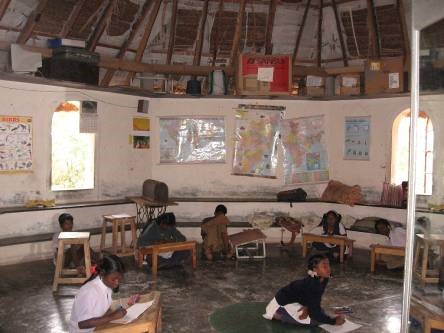
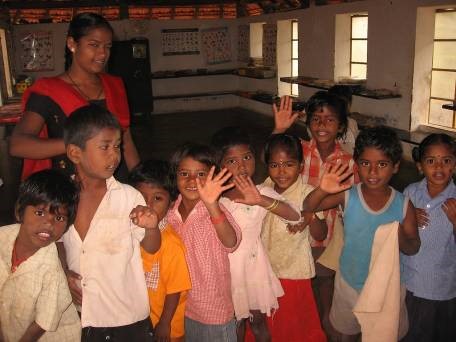
Events around the world:
A glimpse of Asha events and fundraisers
Jai Ho
Asha Danbury
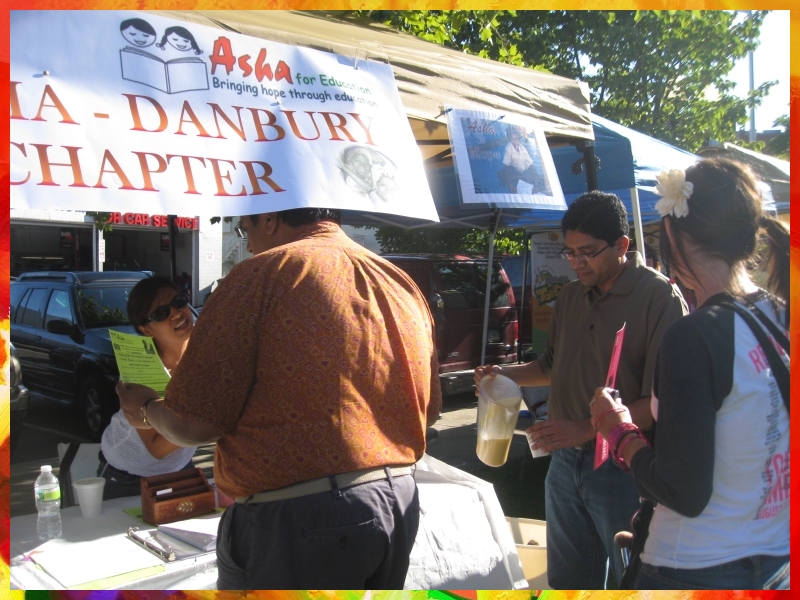
Asha Danbury was launched at the Jai Ho Festival, co-hosted by the Indian Association of Western Connecticut and City Center, Danbury. Our focus for the day was to increase awareness on illiteracy in India. We had meaningful discussions with interested people on education as a means of empowering underprivileged communities. We thank all who attended, especially for their great suggestions. All suggestions were noted and discussed at our meetings to see how we could implement them, some immediately and others in the near future.
5k Run/Walk
Asha NYC/NJ
Asha for Education NYC/NJ chapter hosted the seventh annual 5K Run/Walk to raise funds to educate underprivileged children in India. The event took place on Saturday, 17 April at Riverside Park in New York City. Since its inception in 2004, the 5K Run/Walk events have raised over $100,000 for Asha through individual donations, corporate sponsorships and other contributions. The Asha 5K Run/Walk was a great place to learn about Asha projects, to make acquaintances, to win great prizes and to get involved with a meaningful cause.
Shruti
Asha Athens
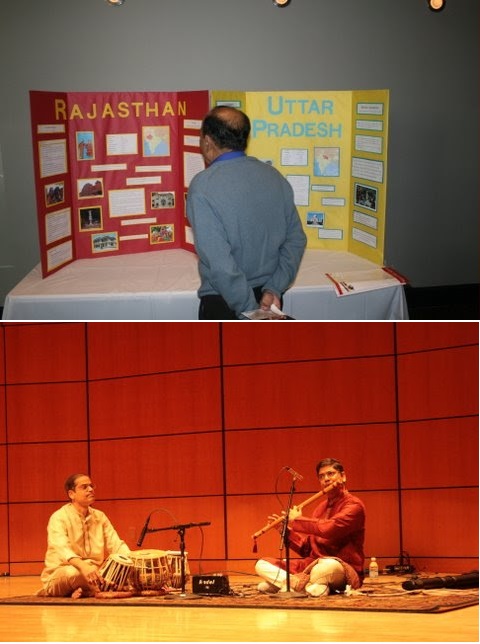
The show (Saturday, 27 February 2010) at University of Georgia Performing Arts Center, Ramsey Hall, was a night of Indian culture, music and a focus on social issues such as education. The event featured flutist Prasad Bhandarkar, a disciple of Pandit Hariprasad Chaurasia, Amitava Sen on the violin and Shekhar Pendalwar on the tabla. There was a dance performance by the University of Georgia dance group Champa & Chameli and an exhibition on Indian culture, social issues and Asha projects around India.
Indian Food Festival
Asha Munich
This fundraising event brought together delicious, internationally renowned Indian cuisine, music and enthusiasm of the Asha volunteers. On 21 August 2010, at EineWelt Haus, guests enjoyed spicy Indian food with a rocking brass band performance. The combination of Indian food with live music was highly appreciated, not only by adults but also by toddlers many of whom came up to the stage to dance to the rocking beats. Another specialty of this event was a creative and novel contribution: “Handmade Rakhi and Jewelry Stall.” A girl, with the help of her parents, put up a stall of handmade rakhi and jewelry and donated the entire proceeds to Asha Munich. The beautiful handmade earrings, necklaces and rakhi illuminated the environment.
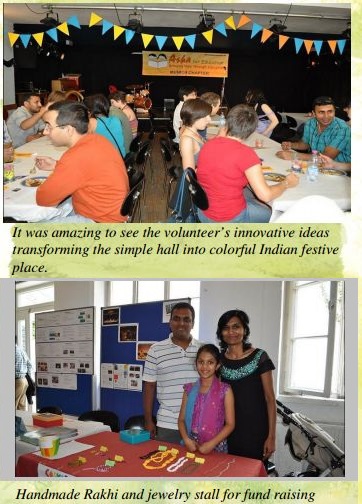
Avehi Abacus
– Asha Seattle Volunteers
The National Council for Teacher Education drafted the National Curriculum Framework (2010) for Diploma in Teacher Education. All states are to revise their syllabi as per NCF 2010 norms. The Avehi Abacus project is part of the committee constituted by the Maharashtra State Board for Teacher Education (which, in turn, is part of the Maharashtra State Council for Educational Research and Training) to review the syllabus. It is an initiative of the Avehi Trust which has worked for quality education for all from 1990. Specifically, it aims to ensure that the material and ethos of courses developed by it are included in the revised syllabus.
The project contributes to the Comprehensive Quality Education Program initiated by the state project director, Sarva Shiksha Abhiyan (SSA). Its objective is to specify quality clauses as per the Right to Education Act 2009 (RTE). It also collaborates with the pedagogy unit of SSA to provide inputs to the Resource Bank of innovative teaching material, thus improving teacher training programs under SSA.
Further, it is engaged in advocacy with All India Forum for Right to Education (AIF-RTE) for repeal of the current act and its replacement by an improved act. At the state level, the project has been an active founding member of the Committee for Equal Fundamental Right to Education (CEFRTE).
Currently the project focuses on two issues: (a) care and education for the 0-6 age group, which is not covered by the RTE and (b) fact-finding, data collection and advocacy for communities in Mumbai affected by demolition.
Thought-provoking supplementary curriculum: After developing a prototype supplementary curriculum from 1990 to 1996, the program gradually spread to all schools in Mumbai Municipal Corporation (MMC) from 2006. The curriculum, titled Sangati, is aimed at 9- to 14-year-olds, i.e., 5th to 7th graders. Sangati is a series of six teaching-learning kits with interlinked themes.
Sangati is being implemented in all upper primary municipal schools of Mumbai since 2009. Kit I (Myself, My Body, Our Needs) and Kit II (Our Earth and the Web of Life) have reached 52,000 children and 1,460 teachers. Kit III (How Societies Developed) and Kit IV (The Way We Live) are being implemented for 6th grade.
Sangati orientation workshops on Kit III were held between 14 July and 5 August for 6th grade teachers. The tremendous response to these workshops led to teachers conducting Kit III sessions regularly. Since Kit III supplements the history syllabus in schools, teachers use kit-based sessions and material to enhance regular classes.
The project team approached the MMC education officer for permission to conduct Kit IV orientation workshops for 6th grade teachers. They were given permission for a one-hour orientation in each school complex. These orientations were held for teachers during December and January. Sessions based on Kit IV are presently being conducted in schools. The kit deals with various social issues reflected in society today, e.g., caste, gender discrimination, communalism, economic inequalities. It is appreciated by students and teachers alike as it provides them an opportunity to critically engage with these issues in the classroom and present views.
Improvement in Teacher Education and Textbook Revisions: The project has developed a supplementary foundation course for Pre-service Teacher Education (Diploma in Teacher Education or DTEd) and was tested in two DTEd colleges between 1998 and 2000. This module is being currently reviewed and finalized. The School Education and Sports Department, Government of Maharashtra, has granted permission to the project to work with select District Institutes for Educational Training (DIET) and a few colleges affiliated to the DIETs, for field testing the module.
Team Asha
Marathon Training, Biking and Climbing Programs
A Poem for All You Superstars!
Coach Rajeev Char, Team Asha Silicon Valley
Their young eyes look out in despair
Their homes and family in disrepair
They look askance upon life, have known nothing at all, but strife…strife
Along come you, and a fortunate few
With marathon dreams and fitness new
Every step you take upon those slopes,
Helps turn their despair into joy & hope.
Every little darkness that you help turn to light,
A million wide-eyed dreams will take flight.
When you doubt yourself at that painful mile,
Just think about them and their joyous smile!
My Tryst with Mt Rainer
Srijan Chakraborty, Asha Seattle
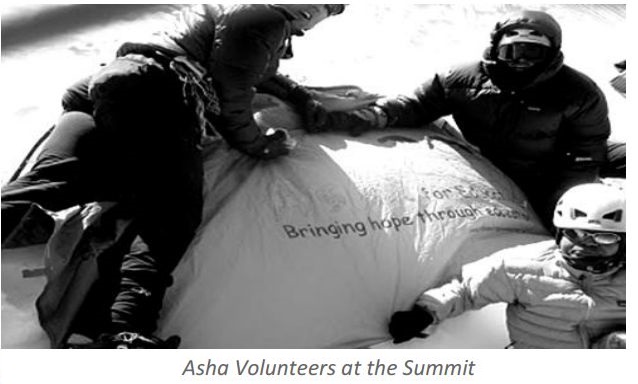
Time: 6:00 pm. Elevation: 14,411 feet. Temperature: well below zero. Wind gusts: up to 50-60 miles per hour.
Not a great combination and I would not fancy being outdoors in such a situation. Yet, I was with three other Team Asha climbers, on top of Mount Rainier on September 5th, 2010. It was painful but still a unique experience and an enjoyable moment! The goal was to summit Mount Rainier to raise funds for my dear non-profit Asha for Education, Seattle Chapter. The journey started almost 6 months back – end of February when our training for the climb begun. Since I’ve moved to the Seattle area, hiking in the mountains with friends has been a part of life in the summer/fall.
But I never thought I’d do anything more technical than that! While hiking had always been fun, training for the climb was not easy. Every time I have gone up a steep slope carrying a 35 lb backpack or had to wake up at an unwieldy time to start a hike, I questioned why I was going through this! When we climbed Mt Adams, the night at the base-camp was so windy and cold that I was almost at the brink of giving up. But once we cross that state of mind and push our limits, the feeling at the end is always one of great achievement and satisfaction. And that satisfaction is multiplied manifold when I know that this effort will help raise essential funds for a cause that’s close to my heart.
Last year an Asha volunteer summited Rainier to raise funds for Asha. This year, a fellow Asha volunteer, Sandeep Nain, and his climber friends offered to guide other novice climbers including me up Rainier. Finding a perfect weekend to attempt the climb was a challenge and it was getting very late in the season. Finally, we decided to try our luck on Labor Day weekend even though the weather was far from perfect – with very cold temperatures and high wind predicted.
Our plan was to take the Disappointment Cleaver route. We were a group of 11 climbers – among them five were experienced climbers and the others were either first time or novice climbers. After getting permits, we started on 4th September morning from Paradise parking lot (elevation 5500 feet) – all geared up carrying our backpacks weighing anywhere from 35 to 65 pounds! It was very foggy and Rainier was nowhere to be seen. As we started climbing we had a few glimpses of Rainier through windows in the cloud! Gradually, as we emerged from under the clouds into sunshine, we could see Rainier and all other major peaks including Mt Adams, Mt Hood & Mt St Helens rising majestically above the clouds.
Our basecamp was Ingraham flats at roughly 11,000 feet. We reached there around 4:30 pm, set up our tents, had dinner, watched a magnificent sunset and slept off promptly. The temperature was frigid and it was extremely windy. In those conditions doing the simplest of the tasks, like tying our shoe-laces, was an effort! You can’t do it with your gloves on and without gloves your hands would freeze!
Our plan was to stay in this camp Saturday night; Sunday do some climbing training, eat, hydrate and sleep early. Then wake up around mid-night and summit early Monday morning. Then we would come down, pack up and go all the way to the trailhead. Our climb-leaders looked at the weather report, talked to the rangers and other guides and found that Monday weather was going to be worse – higher winds, possible snow storm etc. So, there were really two options for us – cancel our plan and go back or make a summit attempt right then! But it was already late (10:30 am) and it’d take a lot of time for us to get ready – so it was almost impossible for all of us to do the summit attempt. There were some hard decisions made and we decided on two rope teams of four climbers each to attempt summit and the other three would stay back. We started to get ready.
By the time we reached Disappointment Cleaver, it was already 2:45 pm and we still had to go a long way to the summit. We would have day light only until 8:00 pm and at that rate we wouldn’t be making it to the summit in time to get back safely. We had to make another hard decision at this time. One of the rope teams was called off and after some reshuffling, 4 of us continued on our way to the summit while the rest turned back. From that point on, it was just a battle of the mind against the elements.
We were all dehydrated, wind gusts were sweeping us off our feet every now and then and we just had to keep walking to keep our body warm. I had to push my limits to keep climbing – only thought in my mind was that I was very close and I knew I could do it! Once we reached the crater, it was a great feeling! The true summit (Columbia Crest) was on the other side of the crater – for that we had to cross the crater and climb the last few feet. It was just adrenalin that carried me through the last few steps!
It was very late (6:00 pm) and the conditions were not really amenable to enjoying our moment of glory. We had to turn back. A long way to get back to the base camp. But not before we took a picture of the Asha-banner at the crater bowl – it was a challenge keeping it down against the blowing wind. We were finally back at our base camp safe and sound around 9:00 pm. Looking back, it was an experience to remember and there were many things to learn from this. I had run couple of half marathons before and also biked more than 200 miles in Seattle to Portland classic bike ride to raise funds for Asha. But nothing really challenged my physical as well as mental limits quite like this. This has to be the hardest thing I’ve ever done in such rough conditions.
While I was hiking up, if you would have asked me if I’d consider climbing Rainier again, I’d have emphatically said that never ever would I even think of doing this! But there is something called the call of the mountain and if you ask me now, my answer would be different!
My Experience with Miles for Smiles
Kalpana Sanghrajka, Asha Seattle
March 2010: A few weeks back, I woke up one morning and signed up for a half marathon. The thought of participating in one had been on my mind for a few years. Fighting the inertia one morning, I did sign-up and that was the beginning of the real fight with myself to give up an hour during the weekday mornings to practice. It’s been a week and it’s not so bad at all. I say, where there’s a will there is a way. That said, if there are hills on the way, I am breathless. So let’s see if the hill or the will gets the better of me.
April 2010: My first walk, was 20 minutes a mile. Walking was not the difficult part, it was forcing myself to make time for it. I was practicing on my own. Hard as it felt initially, I started enjoying it after a while. From 2 miles to 5.5 miles was my progress in one month. Not bad, eh?
May 2010: Early in May, I crossed the half-of-half marathon mark. By then, Team Asha was practicing regularly. Just seeing the level of dedication and enthusiasm put in by the coordinators made me want to help them out. While timing never worked for me to join Team Asha during practice sessions, it became very clear the selfless bunch of coordinators and the coach were dedicated to a cause they truly believed in. Mid-May, I crossed the nine-mile mark! I kicked off my fundraising campaign. With a goal to raise 500 dollars, I wrote a poem for my campaign:
There is a difference I want to make
For those less fortunate
By participating in a half marathon
I want to help them advance
We must be the change we wish to see
Said the great Gandhi
You don’t have to be great to make the change
Small donations can help bridge the disparity
For every 100$ that you vow
Another 25$ I will add
No donation is big or small
A total of 500$ is my goal
I have an incentive to do my best,
God bless, I’ve been fortunate
To be where I am today
A good Samaritan once did the same
Education is the key to success
Your donation will help the underprivileged progress
So do your bit here and now
Go ahead and pledge your vow
June 2010: On the day of the run, I was charged with the energy around me, 27,000 people at 6.00 am all getting ready to run! Wow! Had never before seen that kind of a crowd at that hour. There was music, there was breakfast, there was water, there was cheer and excitement in the air! Along the way, it was fun to see people of all ages running. From little kids to teenagers to those well over my mom’s age! There was never a moment of being alone: there were people cheering all along. Completing the run was quite an experience! I clocked at 13 minutes a mile (down from 20 when I first started practice). Little did I know they gave a medal at the end! It was my very first ever! For all the children that will benefit from the donations, this medal is for you! Though walking 13.1 miles seemed long, it is nothing compared to the struggles you face and rise above. To those reading this article, do consider joining Team Asha, no matter what your endurance level. Training is fun and healthy! You’ll never feel left behind. There’s always a first time and someone to support you.
Baikunthapur Tarun Sangha
– Aritro Sinharoy, Asha Cornell
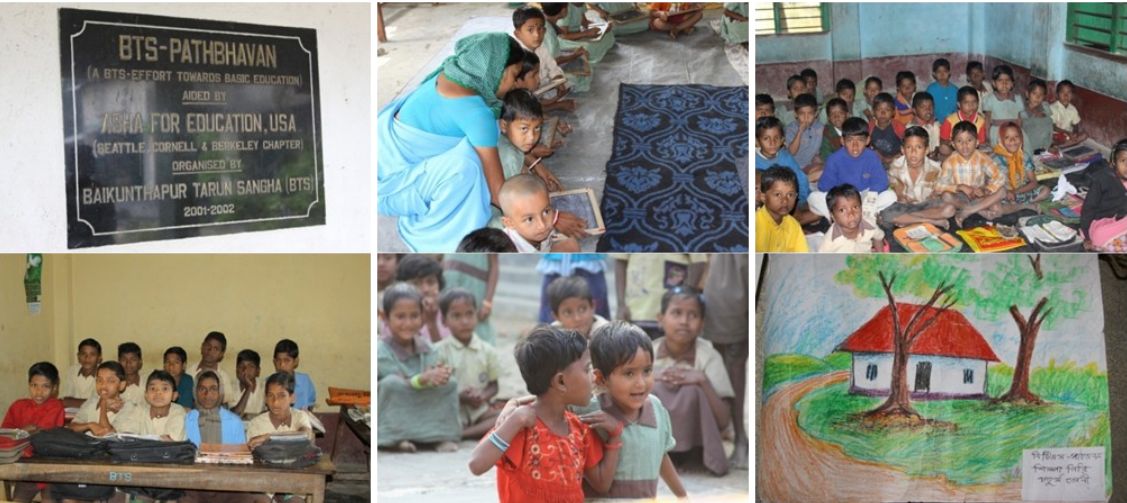
Baikunthapur Tarun Sangha (BTS) is an organization working towards social and economic development in the Kultali block of Sundarbans in West Bengal. Equal right to information, proper healthcare and education for the community are its main goals. Established in 1978, it was acknowledged for its relief work after the major flood in 1982 in the region. BTS serves six villages including Baikunthapur, and is supported by Asha Cornell and various other Asha chapters. It has about 230 students and 14 teachers.
Visit to BTS: Connected to the mainland through rivers and a newly constructed road, Baikunthapur is a three-hour journey from Subhasgram near Kolkata. Susanta Giri, the contact person for the project, gave my friend and me a ride to the site in a car donated to BTS by another US-based non-profit organization. While travelling, we observed some of the areas affected by Cyclone Aila and realized the extent of havoc inflicted on remote rural areas by natural disasters.
First, we visited the hospital. Built for providing healthcare to the community, it was well-maintained. Then we visited Patha Bhavan, the school. Students and teachers gave us a warm welcome. The student strength was impressive in each classroom.
We spoke briefly with Mr Susanta Giri and Mr Chitta Giri, school administrators, about some of the development issues regarding the school. The teachers explained their activity in detail in a separate meeting. We also talked to some students. The enthusiasm of both teachers and students was amazing considering the obstacles they face in their everyday lives. The students were provided with midday meals thrice a week and daily tiffin. The vegetables for the meals are grown by BTS members near the hospital ground using self-produced bio-fertilizers and the food is cooked in the campus. The school also contained a children’s resource library and a computer literacy center, plus six pre-school centers, previously known as child-care centers.
One of the special activities for the students of Patha Bhavan is the “Joyful Learning Process”. Close to the end of school hours, teachers gather students to the playground. They perform group activities ranging from yoga to dancing and singing. This process has become so popular that the students have been invited to perform some of the activities in other schools and competitions.
The plan of action at BTS includes extending the building to accommodate more students, procuring additional solar panels to provide electricity in every classroom and restoring the kitchen damaged by Cyclone Aila.
Tomorrow’s Foundation:
Community-based Alternative Schools in Slums of Kolkata
– Asha Seattle Volunteers
Starting with only 17 children on the terrace of Mother Teresa’s Nirmal Hriday in Kalighat in 1991, Tomorrow’s Foundation today works with 1,519 children in Kolkata and beyond. While remaining true to its principal focus on education of underserved children, it has expanded its activities to include community-based health services, vocational training for young adults and disability services. The foundation has also spread its activities beyond West Bengal. Last year, it started working in Dantewada district in Chhattisgarh with orphaned children and plans to work in Orissa this year.
Asha Seattle has been supporting 14 Community Education and EmPowerment centers (CEEP) run by Tomorrow’s Foundation in south and east Kolkata. Originally known as Community Based Education Project (CBEP), the centers have added the community empowerment to their activities by working with parents and young adults.
CEEPs are small centers, often in neighborhood clubs. Their main aim is to help educate slum children who have either never gone to school or have dropped out of schools after only a few years. The centers provide three types of services to these children: (a) balwadi, (b) bridging courses for dropouts and (c) coaching centers providing school-goers with educational support.
Last year, Tomorrow’s Foundation collaborated with “Gali Gali Sim Sim” to distribute effective educational kits and teachers’ training material which are now being used at the centers to make learning fun and relevant. Monthly teachers training programs are also held for all teachers at these centers. These services go a long way in mainstreaming children by preparing them to be admitted to local government schools and enabling them to stay in school. 204 children in the 9-14 age groups have been mainstreamed in 2009-10.
Over 2009-10, Tomorrow’s Foundation has implemented an innovative program, (supported by another funding agency) tilted “Hole in the Wall”, at two CEEPs. The program comprises of simply placing a wooden cabinet with two computers in an open location. The computers are completely unmonitored and any child, irrespective of whether it is enrolled at the CEEP, can play attractive educational games for as long as it wants completely free of charge. This program has shown much promise being very popular among children who cannot access computers otherwise.
Further, since last year CEEPs are educating illiterate adults, especially giving mothers vocational training based on market needs thereby creating earning opportunities. The centers have also started to train community teachers, mobilizers, health workers and mothers in primary health-care and disability-related issues. Centers also liaise between health-service providers and governmental & non-governmental organizations involved in health-care, education, family planning and improvement of water & sanitation.
CEEPs have started focusing on physically challenged children as well. In 2009-10, the centers identified children with special needs. These children receive inputs according to their specific needs. In the coming year Tomorrow’s Foundation plans to start a “Special Education On Wheel” to better serve these children.
Financial Reports
Asha-wide Treasury Team
Presented below is a summary of Asha for Education’s finances for the year 2010. Detailed financial reports, including our IRS form 990, can be found here.
Asha-wide Financials
| Heading | Amount |
| Opening Balance | $6,685,883.5 |
| Total Income | $3,448,770.6 |
| Project Disbursements | $3,102,322.9 |
| Total Expenses | $3,536,455.6 |
| Ending Balance | $6,598,198.4 |
Chapter-wise Financials
| Chapter | Opening Balance | Total Income | Total expenses | Ending Balance | Project Disbursement | ||||
| Ann Arbor | 17,033 | 8,258 | 64 | 25,226 | – | ||||
| Arizona | 202,588 | 27,935 | 38,851 | 191,671 | 38,800 | ||||
| Athens | 18,855 | 7,198 | 20,052 | 6,001 | 20,000 | ||||
| Atlanta | 34,804 | 19,464 | 36,105 | 18,163 | 35,660 | ||||
| Austin | 68,393 | 90,452 | 130,323 | 28,521 | 126,046 | ||||
| Ballia | 2,415 | 2,505 | 66 | 4,854 | – | ||||
| Bangalore | 13,699 | 14,016 | 11,236 | 16,479 | 10,125 | ||||
| Berkeley | 133,384 | 27,111 | 68,302 | 92,193 | 67,493 | ||||
| Birmingham | 5,954 | 4,222 | 2,000 | 8,177 | 2,000 | ||||
| Boston | 175,400 | 70,022 | 87,209 | 158,213 | 86,682 | ||||
| Burlington | 7,939 | 2,939 | 0 | 10,877 | – | ||||
| Canada | 2,485 | 2,672 | 11 | 5,146 | – | ||||
| CFL | 1,562 | 1,160 | 1,435 | 1,287 | 1,400 | ||||
| Chennai | 30,701 | 52,700 | 55,577 | 27,824 | 54,500 | ||||
| Chicago | 246,646 | 59,193 | 89,340 | 216,499 | 77,406 | ||||
| Cincinnati | 20,411 | 8,730 | 2,484 | 26,658 | 2,450 | ||||
| Cleveland | 31,925 | 29,346 | 23,138 | 38,132 | 22,020 | ||||
| CNJ | 96,946 | 46,325 | 45,924 | 97,347 | 45,126 | ||||
| Colorado | 64,959 | 25,423 | 11,278 | 79,104 | 11,241 | ||||
| Cornell | 37,652 | 7,979 | 16,557 | 29,074 | 16,500 | ||||
| Corvallis | 15,419 | 3,498 | – | 18,917 | – | ||||
| Dallas | 91,955 | 66,932 | 59,874 | 99,012 | 59,061 | ||||
| Danbury | – | 15 | 0 | 15 | – | ||||
| DC | 130,854 | 38,901 | 36,292 | 133,463 | 35,432 | ||||
| Delaware | 25,114 | 2,589 | 5,002 | 22,701 | 5,000 | ||||
| Delhi | 7,204 | 2,816 | 6,181 | 3,840 | 6,000 | ||||
| Detroit | 26,387 | 26,819 | 38,390 | 14,816 | 37,910 | ||||
| Eindhoven | 2,559 | 19 | – | 2,578 | – | ||||
| Frankfurt | 2,085 | 16 | – | 2,100 | – | ||||
| Hartford | 9,317 | 9,472 | 2 | 18,787 | – | ||||
| Houston | 26,698 | 19,724 | 12,825 | 33,596 | 12,500 | ||||
| Hyderabad | 25,382 | 9,510 | 16,764 | 18,128 | 16,560 | ||||
| Irvine | 24,982 | 5,424 | 8,034 | 22,372 | 8,000 | ||||
| Kanpur | 6,108 | 297 | 8 | 6,398 | – | ||||
| KansasCity | 29,849 | 23,344 | 20,593 | 32,601 | 20,409 | ||||
| Knoxville | 9,638 | 4,144 | 4,915 | 8,867 | 4,900 | ||||
| LA | 44,885 | 5,775 | 3,057 | 47,603 | 3,000 | ||||
| Lalpur | 2,499 | 2,294 | – | 4,792 | – | ||||
| London | 6,734 | 5,322 | 2,090 | 9,967 | 2,000 | ||||
| Lucknow | 2,370 | 3,078 | 23 | 5,425 | – | ||||
| Madison | 39,940 | 6,571 | 3,427 | 43,085 | 3,420 | ||||
| MHV | 113,378 | 6,376 | 15,011 | 104,743 | 15,000 | ||||
| Minnesota | 27,173 | 24,162 | 12,432 | 38,903 | 12,271 | ||||
| MSU | 7,586 | 100 | 7,686 | – | – | ||||
| Mumbai | 20,811 | 7,857 | 18,484 | 10,185 | 18,336 | ||||
| Munich | 2,089 | 2,290 | – | 4,380 | – | ||||
| NRV | 2,903 | 6,936 | 4,753 | 5,087 | 4,750 | ||||
| NYCNJ | 664,460 | 293,113 | 362,202 | 595,371 | 347,370 | ||||
| PennState | 1,987 | 100 | 2,087 | – | – | ||||
| Philly | 23,206 | 12,072 | 2,837 | 32,441 | 2,562 | ||||
| Portland | 17,864 | 13,331 | 8,011 | 23,183 | 7,945 | ||||
| Princeton | 47,266 | 32,400 | 19,623 | 60,043 | 19,215 | ||||
| Pune | 5,716 | 3,095 | 91 | 8,719 | – | ||||
| Purdue | 15,331 | 3,793 | 6,011 | 13,113 | 6,000 | ||||
| R&R | 7,057 | 20,632 | 20,000 | 7,689 | 20,000 | ||||
| Rajatalab | 121 | 25 | 1 | 146 | – | ||||
| Redlands | 21,509 | 5,204 | 7,263 | 19,450 | 7,250 | ||||
| SB | 21,341 | 3,514 | 2,080 | 22,774 | 2,000 | ||||
| SD | 27,338 | 26,344 | 7,634 | 46,048 | 7,500 | ||||
| Seattle | 1,093,811 | 739,981 | 801,563 | 1,032,230 | 791,069 | ||||
| SF | 100,419 | 42,251 | 29,170 | 113,499 | 28,600 | ||||
| Sheffield | 320 | 758 | 23 | 1,056 | – | ||||
| SLC | 10,850 | 2,437 | 53 | 13,235 | – | ||||
| Stamford | 39,244 | 14,991 | 18,306 | 35,929 | 17,700 | ||||
| Stanford | 75,083 | 100,500 | 60,540 | 115,043 | 59,819 | ||||
| StLouis | 27,375 | 20,448 | 19,437 | 28,386 | 18,850 | ||||
| SV | 590,859 | 576,153 | 730,517 | 436,495 | 712,896 | ||||
| Toledo | 19,860 | 12,083 | 68 | 31,875 | – | ||||
| Tsunami | 32,859 | 219 | 3,515 | 29,563 | 3,515 | ||||
| Uflorida | 49,542 | 37,314 | 25,491 | 61,365 | 24,500 | ||||
| UIUC | 65,361 | 24,258 | 31,548 | 58,071 | 30,334 | ||||
| Varanasi | 3,129 | 3,205 | 27 | 6,307 | – | ||||
| Wide | 1,779,462 | 656,082 | 454,431 | 1,981,113 | 105,200 | ||||
| Yale | 23,803 | 10,239 | 8,135 | 25,907 | 8,000 | ||||
| Zurich | 3,042 | 2,298 | – | 5,340 | – | ||||
| Total | $ 6,685,884 | $ 3,448,771 | $ 3,536,456 | $ 6,598,198 | $ 3,102,323 | ||||
Asha Fellow – Muthyalappa
– Asha Bangalore Volunteers
We lost Asha-Fellow Muthyalappa early this year on 5 April 2010. Muthyalu was the sarpanch of Mushtikovela Panchayat from Sep 2006. Mushtikovela Panchayat is situated in the second most drought-prone district in the country, Anantapur. It covers four villages: Mushtikovela, Subbarayanapalle, Guvvalagndipalle and Burjaguttapalle. Its population is 2,500. 4,000 acres of land fall under its jurisdiction, of which only 900 acres are cultivated because the soil is poor, water is scarce and wild boars attack the crop. Consequently, many people migrate for work.
Asha supported Muthyalu in his work from June 2007. As sarpanch, he worked hard to ensure proper implementation of the National Rural Employment Guarantee Act (NREGA) in his panchayat. He was successful in channeling over ₹1.15 crore during his tenure.
Prior to becoming sarpanch, Muthyalu worked for seven years in various capacities with Timbaktu Collective, an NGO working in three mandals in Anantapur. His initial work was in Natural Resource Management (NRM) to strengthen forest committees. He was later in charge of the collective’s watershed program in Roddam mandal.
His exposure was very helpful during his tenure as sarpanch when he used NREGA for conserving and building on natural resources, especially watershed management. Another experience that proved very helpful was the Panchayati Raj (PR) program where he was involved in training of the PR functionaries, sarpanches and secretaries on the powers and responsibilities of PR institutions. He worked as the coordinator of the PR and NRM programs before he became the Mandal leader for all the collective’s activities in Roddam mandal in 2005. He also worked in Timbaktu’s Thrift Co-operative Society (Ananthashakthi), their youth program (Yuvatha) and their program for the disabled (Militha).
He was a contributor and editor of “Mungari”, the internal newsletter of Timbaktu Collective. He also worked part-time as a reporter for Andhra Bhoomi, a statewide Telugu newspaper as their Roddam mandal correspondent. For a short time, he was a reporter for Prajashakthi newspaper as their CK Palli correspondent.
We recollect some of the impact of his work here, in his memory.
- NREGA: Muthyalu was instrumental in implementing NREGA effectively in his Panchayat. The scheme was in effect before he became sarpanch. However, it was underutilized: People were not aware of it and officials did not make enough effort to implement it. Only around ₹25,000 were earned by people in the Mushtikovela Gram Panchayat before Muthyalu’s tenure. From September 2006 to date, over a crore of rupees were earned. There were about 1,400 job-card holders and families earned ₹7,000 to ₹15,000. In several cases they could pay off loans and use the money for other income generation activities. This income has reduced migration by 85%.
In the initial months when the scheme was implemented, the major work was making bunds in agricultural land. People then worked on watershed management and housing. Initially, Muthyalu was very involved in getting the scheme to work at various levels. He worked towards filling gaps in the process – between the mandal-level MDO, technical assistants and field assistants. He was also the interface between labor and technical assistants. Over time, he created processes that do not require his involvement to the same level. Worker groups were formed who came up with a list of possible actions, checked for feasibility, prioritized and took decisions. As vice-president of the Sarpanch Union, he was able to motivate other village leaders to employ NREGA effectively in their gram panchayats. - NRM: Muthyalu had worked with Timbaktu Collective on NRM and put his experience to use through NREGA. Diversion drains were dug to channel water from hills and sloping areas to a desired location, for example, an existing stream. This prevents water from flowing broadly across the landscape, flooding residential areas and leading to soil erosion. Farm ponds were constructed. They are used for local irrigation, recharging wells and providing water for cattle. Stone bunding was done to set up barriers across land to control the speed of flowing water and curtail soil erosion. Pebble bunding was done for the same purpose in relatively flat areas.
- Tank desilting was also done as part of NREGA. A large tank adjoins Mushtikovela village. It supplies water for over 480 acres of fields. Accumulated silt was dug out of the tank when it was dry and transported by tractor to fields to improve fertility and increase the capacity of the tank.
Muthyalu is survived by his wife and child. Our condolences are with them as they continue their journey without him.

Inspiration from Bollywood: 3 Idiots
To Rote or not to rote
Aparna Ashok, Asha Cornell
The education system in India, one of the many legacies of the British Raj, is highly structured and rigid. Although these qualities have been successful in turning out top scholars, the vast majority of students do not benefit from the educational strategies employed by schools and colleges across the country. This realization is not new. It has been addressed in print, in speech, in electronic media and, most recently, in film. Bollywood’s frank portrayal of the common teaching practices in movies such as “3 Idiots” has been integral in exposing some of the pitfalls of the Indian perspective on education.
Emphasis on memorization or rote learning is one of the major downfalls of the current system. Mary Pettibone Poole wrote, “To repeat what others have said, requires education; to challenge it, requires brains.” In essence, she tries to communicate that repetition is mindless, while curiosity is the mark of intelligence. 3 Idiots illustrates this point through the juxtaposition of the protagonist, Rancho, and the antagonist, Chatur. Chatur’s character is based upon the classic intellectual student: book smart and extremely competitive with immense ability to learn by heart. On the other hand, Rancho is carefree, inquisitive and passionate about learning. Chatur’s tried and true strategies impress the professors, while Rancho’s fresh perspective is repeatedly denigrated. Ironically Rancho always bests Chatur. Hence, the triumph of the atypical student symbolizes the superiority of problem solving over rote learning. The advantages of problem solving are rooted in conceptual understanding. While memorization seeks to teach students concepts by repetitive exposure, problem solving relies on a student’s understanding and application of the ideas presented.
This disparity is crucial in fields such as engineering, science and business where the reiteration of concepts presented in textbooks is not nearly enough to solve the problems of the 21st century. Thus, it is imperative that students be able to use their knowledge to drive invention and innovation. Rancho exemplifies this aptitude in the construction and use of the power inverter for the delivery of a baby in 3 Idiots. As far as a real-world example is concerned, consider the pioneering of laparoscopic surgery by Dr Hans Christian Jacobaeus. Needless to say, problem-solving approaches have driven the progress of the human race.
All said and done, rote learning is not completely ineffectual. It is highly appropriate in primary education. The study of basic sequences, such as alphabets and numbers, historical events and faces, all rely on memorization. However, the appropriateness and value of memorization as an instructive tool is highly questionable in secondary and higher education. One cannot hope to do justice to subjects like physics, chemistry and mathematics by learning formulae by heart. A grasp of the underlying theories is key to the use of the formulae and can only be attained through problem solving techniques. Therefore, rote learning has its place in education but it cannot replace the need for problem solving in advanced study.
India is one of the many countries that place heavy emphasis on rote learning. An unfortunate consequence is the success of students like Chatur notwithstanding students like Rancho. Whether the education sector has realized the merits of Rancho’s approach remains uncertain but it seems the film industry has deemed it important enough to showcase the superiority of problem solving over rote learning. If teachers in schools and colleges accordingly take a cue from Bollywood and design a curriculum that is more student-friendly, All Izz Well.
An Idiotic Realization
Anish Borkar, Asha Cornell
Dearth of innovative thinking in education has not received the consideration that it deserves. However, Bollywood has recently shed some light on this important issue with the blockbuster “3 Idiots”. The protagonist, Rancho, constantly tries to demonstrate to his class and the dean the uninspired state of education today through comedic, dramatic and tragic devices. In the process, he wins over the audience with the simple philosophy that learning should be an enjoyable process. Director Rajkumar Hirani and his crew have attempted to instill a sense of urgency and an imminent need for change in the Indian education system.
As we know, the race of life begins the day a child is born. In this race driven by parental pressure, a key aspect of education is lost: the act of learning. The initial stages of learning may just be memorizing ABC or multiplication tables but after that, knowing the definition of a machine simply does not cut it.
Although this sounds obvious, it is sometimes hard to believe what a student receiving an education at a top-notch college is really learning. Is every student studying engineering striving to invent a new product that may change the way we live? Is every economics major fighting to find a solution to Zimbabwe’s hyperinflation or fix the world’s financial crisis? No. They are struggling to find the best jobs or go to the best graduate schools. The thought of working for a top investment bank or getting into a prestigious professional school is the force that drives students to “study” and meet the grade. Therein lies the fundamental problem: The learning mind’s expansion – and its increasing capacity to produce innovative ideas and creative solutions – hits a wall of parental pressures, inevitable peer competition and a plethora of tests, projects and deadlines. As a result, the idea of “studying” ceases to exist.
Although it is difficult to look on a movie as the conveyer of an essential message, we need to, at least, advocate the obvious shortcomings of the current education system. Eradicating tests or starting a school where students work with real machines may not be the most practical way to approach things. However, there are high schools today where the concept of testing does not exist. For example, the New College of Florida uses a personal written assessment for every student at the end of its four-year course, instead of a transcript. And for those skeptical of this practice, this school does have placements into the top universities. Building on this, colleges can also cut down their class sizes and begun to restructure curricula so that students learn from and research under a professor in the field they are working in. This would not only encourage learning at a personal level, but also encourage innovation in young minds, often leading to ground-breaking research.
Competition is just a product of human nature as we all strive to be better than others. However, we have to realize that each person has his or her own unique strengths and weaknesses and we can do wonders for mankind if we all pool these strengths. We do not necessarily have to compete against each other; instead, we should work with each other and compete with ourselves, for there is always room for improvement.
Board of Directors
| President | Ravi Kandikonda | president@ashanet.org |
| Secretary | Srikanth Pilla | secretary@ashanet.org |
| Treasurer | Akshay Bhole | treasurer@ashanet.org |
| Director, Projects | Padmanava Sen | projects@ashanet.org |
| Director, Fundraising | Anish Johnson | fundraising@ashanet.org |
| Director, Web | Saurabh Madan | webmaster@ashanet.org |
| Director, PR | Alivia Sil | pr@ashanet.org |
Annual Report Team
Pradeep Jayaraman and Pabitra Chatterjee
Proofreading by Venkatesh Iyengar.
Thanks to all volunteers who contributed articles, photographs and other content for the Annual Report. We would also like to thank every member of Asha for Education for their valuable inputs and suggestions.
